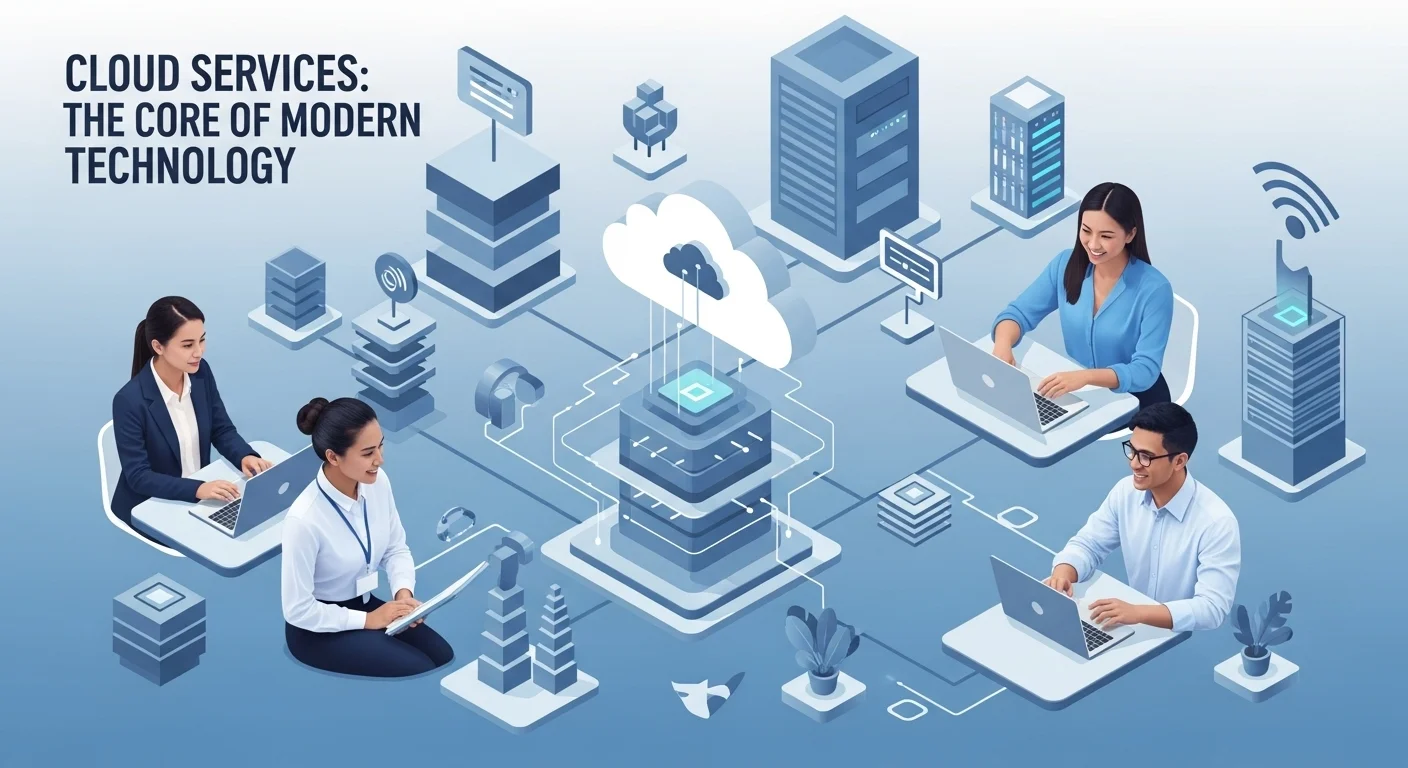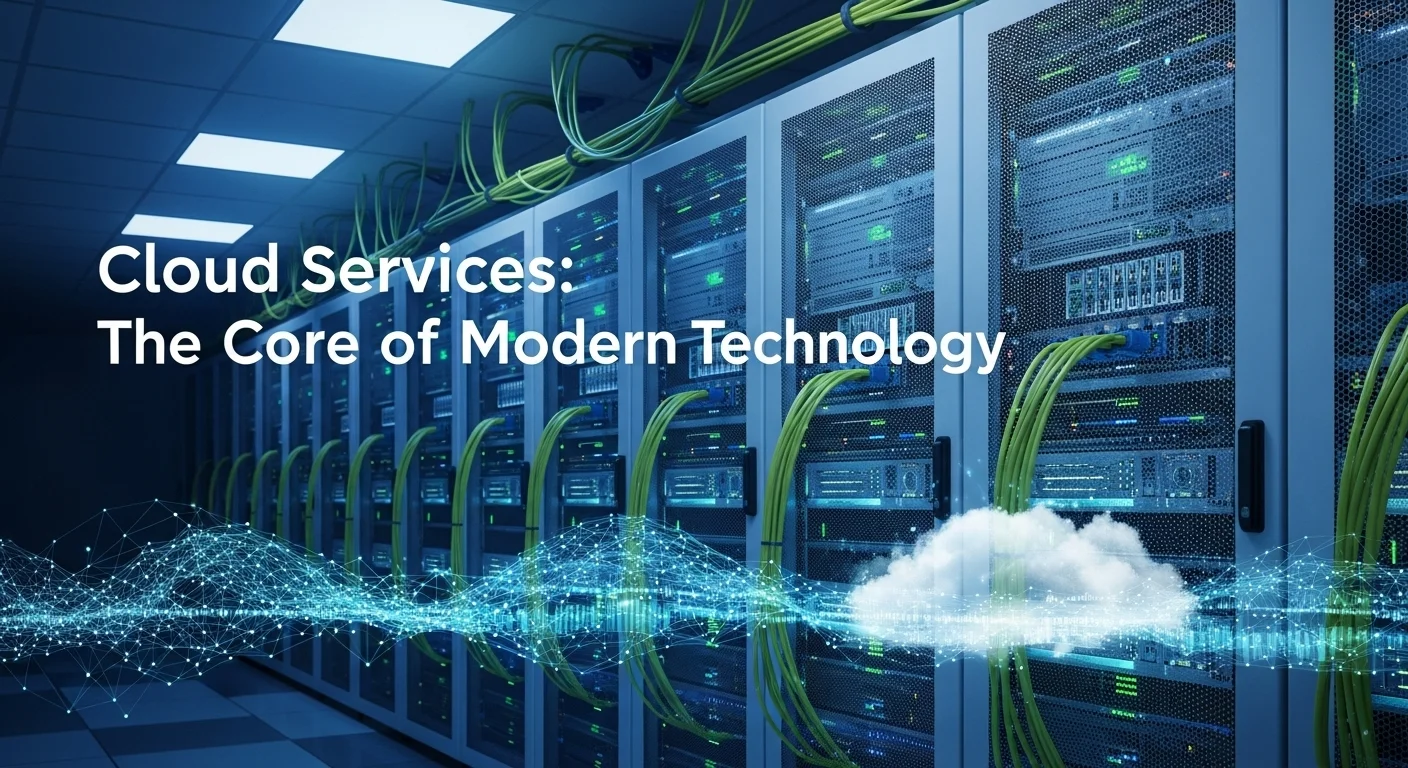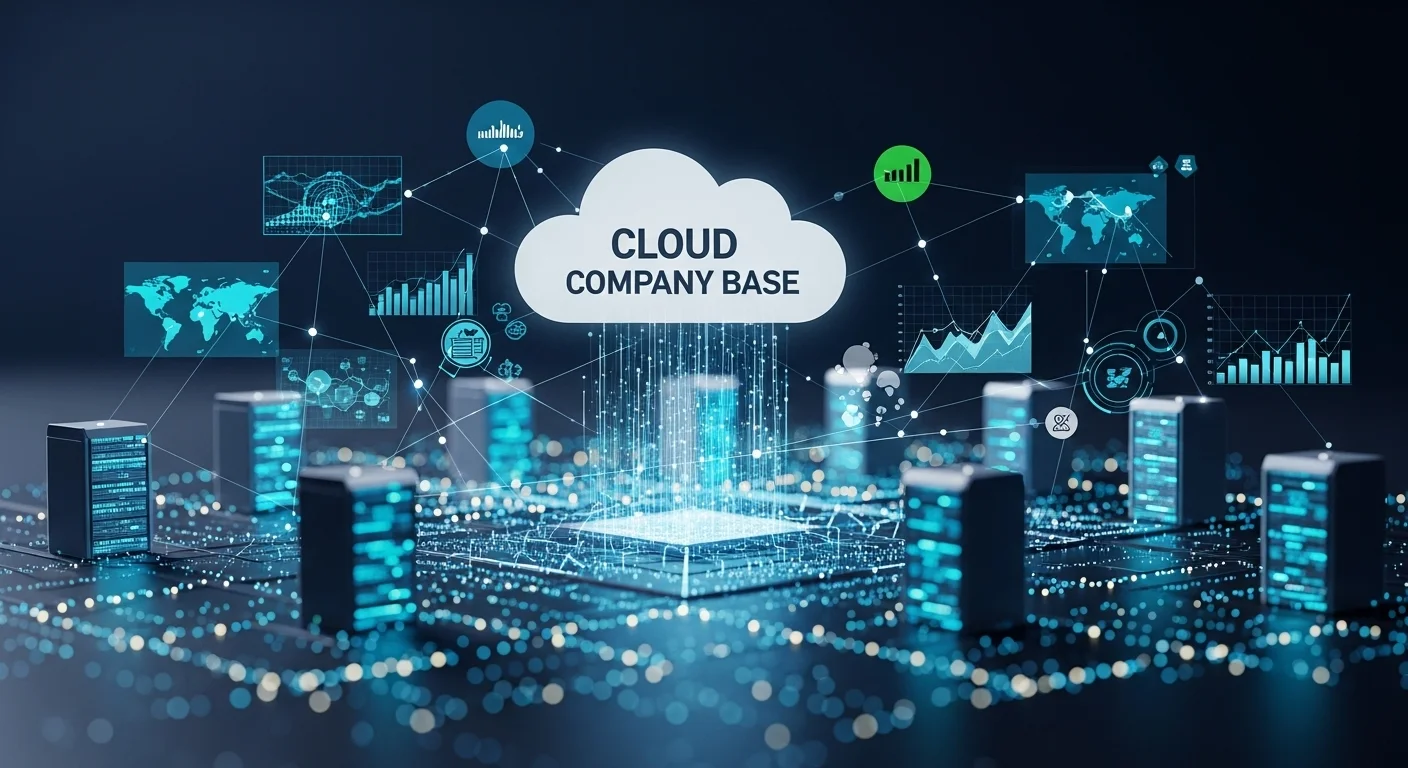Cloud Services Explained: Your Simple Guide to How the Cloud Really Works

Executive Summary
I’ve spent over a decade helping businesses navigate the move to the cloud, and trust me, the biggest hurdle is often just understanding what it *is*. It isn't some magical, abstract place; it's a powerful and tangible shift in how we use technology. This article is your roadmap. I'm going to break down everything you need to know, from the basic building blocks like IaaS, PaaS, and SaaS to the different types of clouds you can use. We'll explore how these tools enable incredible things like scalable data storage, super-fast processing, and even advanced machine learning, all without needing a server room in your office. My goal is to show you, in plain English, how leveraging these services can cut costs, boost security, and give you the agility to outpace the competition. Let's demystify the cloud together and unlock its potential for your growth.
Table of Contents
What Are Cloud Services and Why Do They Matter?
If you've been around the tech or business world lately, you've heard the term 'Cloud Services' everywhere. But what does it actually mean? For a long time, it felt like a buzzword for 'somewhere on the internet.' In reality, it's quite simple: cloud services are computing resources—like servers, storage, software, and databases—that you access on-demand over the internet from a provider. Think of it like your electricity bill. Instead of building your own power plant, you just plug into the grid and pay for what you use. That's the cloud in a nutshell. You can tap into incredible computing power from providers like Amazon Web Services (AWS), Microsoft Azure, or Google Cloud instead of buying and managing your own expensive hardware. I remember the days of waiting weeks to procure and set up a new server. Now, developers can get one running in minutes. This shift is monumental. It has leveled the playing field, allowing small startups to use the same high-end technology as multinational corporations. The key is scalability. Your resources can grow or shrink instantly based on your needs, so you aren't paying for idle equipment. This agility is what fuels innovation today. It’s the foundation for almost everything digital you interact with, from the apps on your phone to e-commerce sites and the ever-growing Internet of Things (IoT).
Understanding the Core Models of Cloud Services
To really get a handle on the cloud, it helps to think of it in three main layers: IaaS, PaaS, and SaaS. I like to use a pizza analogy to explain this, but let's stick to a more direct approach here. Each model offers a different level of control and is suited for different needs.
Infrastructure as a Service (IaaS)
IaaS is the most foundational layer. Essentially, you're renting the raw IT infrastructure—the virtual servers, networks, and storage—from a cloud provider. It’s like leasing a plot of land and getting access to raw building materials. You have the most flexibility and control here. You choose the operating system, install your own software, and configure everything yourself. The provider just handles the physical data centers and hardware. This is perfect for companies that want deep control over their environment or have very specific infrastructure needs. It's the starting point for powerful cloud processing services, where you can provision virtual machines to handle heavy workloads without touching a physical server.
Platform as a Service (PaaS)
PaaS takes it one step further. The provider manages the underlying infrastructure *and* the operating systems, middleware, and development tools. It’s like renting a fully equipped workshop. You don't have to worry about maintaining the tools or the building; you can just walk in and start creating. This is a dream for developers because it lets them focus entirely on writing and managing their applications. The platform handles all the backend complexity of deployment and scaling. Many modern cloud data services, like managed databases that automate backups and updates, fit perfectly into this model, saving teams countless hours of administrative work.
Software as a Service (SaaS)
SaaS is the model most people are familiar with, even if they don't know the term. This is ready-to-use software you access over the internet, typically on a subscription basis. Think of it as moving into a fully furnished, all-utilities-paid apartment. You just bring your personal belongings and start living. The provider handles absolutely everything—the hardware, the software, the updates, the security. Services like Gmail, Salesforce, and Microsoft 365 are classic examples of SaaS. These common cloud services are indispensable for modern businesses, providing sophisticated tools with virtually zero IT setup.
The Business Applications and Transformative Benefits
Adopting cloud services has opened up possibilities that were once pure science fiction for most businesses. The most dramatic impact I've seen is in the world of data. Companies can now afford to store and analyze enormous datasets using cloud data services to find patterns and make smarter decisions. This is powered by immense cloud processing services that can crunch numbers at a scale that was previously unthinkable. An area I'm particularly passionate about is how cloud services for machine learning have democratized AI. Providers offer toolkits that make it easier for businesses of all sizes to build things like fraud detection systems, customer service chatbots, and product recommendation engines. Beyond the high-tech applications, the fundamental benefits are just as transformative. The cost savings from shifting from large capital investments to predictable operational costs are huge. The global reach is another game-changer; with a few clicks, you can deploy your application in data centers around the world to serve customers faster. And finally, security. Cloud providers invest billions in security, often providing a more secure environment than what most companies could build on their own. It’s not just about saving money; it's about building a more agile, innovative, and resilient business.

Your Complete Guide to Cloud Tech and Business Solutions
Getting started with cloud services is one thing, but truly mastering them to drive your business forward is another. To do that, you need to go beyond the basics and understand the technical details, the key players, and the strategies for success. Let's pop the hood and take a look at how these services work in practice and how to make the right choices for your goals. Embarking on a cloud journey is a major strategic move, and I've seen firsthand how picking the right services can be the difference between a soaring success and a costly failure.
A Deeper Dive: IaaS, PaaS, and SaaS in Action
Let's get a bit more technical to see how these models deliver value. Each one provides a different set of tools designed for specific jobs.
IaaS: Building From the Ground Up
At the IaaS level, you're working with the core components: virtual machines (VMs), storage, and networking. Providers like AWS, Azure, and Google Cloud offer a huge menu of VMs optimized for different tasks—some for general computing, others packed with memory or powerful GPUs. This is the heart of cloud processing services. For storage, you have options like block storage, which acts like a virtual hard drive for your VM, and object storage, which is perfect for storing massive amounts of unstructured data like photos and videos. Object storage is a pillar of modern cloud data services due to its incredible scale and durability. You also get to design your own virtual network, creating isolated, secure zones (often called Virtual Private Clouds or VPCs) to launch your resources, giving you precise control over how everything connects.
PaaS: The Developer's Best Friend
PaaS is all about abstraction—hiding the complex infrastructure so developers can just build. A key feature here is the managed application environment. With services like AWS Elastic Beanstalk or Heroku, you just upload your code, and the platform handles all the tedious work of deployment, load balancing, and scaling. Another huge win for developers is managed databases. Services like Amazon RDS or Azure SQL Database take care of all the painful administrative tasks like patching and backups, freeing up developers to focus on building great features. More recently, PaaS has been transformed by containers and serverless computing. Managed Kubernetes platforms (like Amazon EKS or Google GKE) make it easier to run applications packaged in containers, while serverless offerings like AWS Lambda let you run code without thinking about servers at all. You literally just pay for the milliseconds of compute time you use.
SaaS: Ready-to-Go Solutions
From a technical perspective, SaaS is the simplest for you as a user because the vendor manages the entire stack. You just log in through a web browser or API. But behind the scenes, the technical complexity is immense. The provider is managing a global, multi-tenant architecture with sophisticated security and load balancing to ensure the service is always available and performant for millions of users. The most common cloud services we use daily, from Google Workspace to Zoom, are marvels of SaaS engineering.
The Explosion of Specialized Cloud Services for Machine Learning
One of the most exciting developments I've witnessed is how the cloud has made artificial intelligence accessible to everyone. The major providers have built incredible platforms specifically as cloud services for machine learning that simplify the entire process. These services typically include:
- Data Labeling: Tools that help you create high-quality training data for your models.
- Managed Notebooks: Ready-to-use development environments for data scientists to explore data and build models.
- Model Training: On-demand access to incredibly powerful computers (including GPUs and custom AI chips) to train complex models in a fraction of the time it would take otherwise.
- AutoML: Services that automate model creation, allowing even non-experts to build high-quality predictive models.
- Model Deployment: Tools that let you deploy your trained model as a live API with just a few clicks, ready to be integrated into your applications.
Comparing the Titans: AWS vs. Azure vs. Google Cloud
While there are many cloud providers, the market is dominated by three giants. Choosing between them is a big decision, and there's no single 'best' one—it depends entirely on your needs.
- Amazon Web Services (AWS): The pioneer and market leader. AWS has the most extensive range of services and the largest community. I find that startups and tech-forward companies often gravitate to AWS for its flexibility and sheer breadth of options.
- Microsoft Azure: The strong number two, especially in the corporate world. Azure's killer feature is its deep integration with other Microsoft products like Office 365 and Windows Server. For large enterprises already invested in the Microsoft ecosystem, it's often the most logical choice for building a hybrid cloud.
- Google Cloud Platform (GCP): A powerful contender known for its top-tier expertise in specific areas born from Google's own internal needs. It's a leader in data analytics, machine learning, and container technology (it created Kubernetes). I often recommend GCP to data-heavy companies focused on building modern, cloud-native apps.

Tips and Strategies to Master Your Cloud Experience
Moving to the cloud is a journey, not a destination. To truly get the most out of it, you need to think strategically about how you manage it. Over the years, I've seen where people succeed and where they stumble. Here are some of the hard-won lessons and practical tips to help you manage costs, tighten security, and optimize performance. Getting this right is how you turn your cloud investment into a real competitive edge.
Mastering Cloud Costs: A FinOps Approach
The pay-as-you-go model is fantastic, but it can be a double-edged sword. Without careful management, costs can balloon unexpectedly. This is where FinOps comes in—it's a practice that brings financial discipline to your cloud spending so there are no nasty surprises at the end of the month.
Key Cost-Saving Strategies:
- Right-Size Your Resources: This is the lowest-hanging fruit. I see it all the time: teams provision oversized servers 'just in case' and end up wasting a ton of money. Analyze your usage and shrink your resources to match what you actually need.
- Use Smart Pricing Models: Don't just pay the on-demand rate. For steady workloads, commit to a one- or three-year plan (like Reserved Instances) to get massive discounts. For tasks that can be interrupted, use Spot Instances to access spare capacity for up to 90% off.
- Automate Shutdowns: Your development and test environments don't need to run 24/7. Set up simple scripts to turn them off on nights and weekends. This can easily cut their costs by more than half.
- Hunt Down 'Orphaned' Resources: It's easy to delete a server but forget to delete the storage volume attached to it. These 'orphaned' resources just sit there, quietly racking up charges. Run regular checks to find and eliminate them.
- Watch Your Data Transfer Costs: Moving data into the cloud is usually free, but moving it out costs money. Design your applications to minimize data egress and use a Content Delivery Network (CDN) to serve content from locations closer to your users. This is especially vital for large-scale cloud data services.
- Be Smart with Machine Learning Costs: The powerful GPUs used in cloud services for machine learning are expensive. Only use them for active model training, not for everyday tasks. For deploying models, look at serverless options that are more cost-effective for intermittent traffic.
Fortifying Your Cloud: Security Best Practices
Cloud security is a shared responsibility. I explain it like this: the provider is responsible for the security *of* the cloud (the physical data centers), but you are responsible for security *in* the cloud (your data, users, and applications).
Essential Security Strategies:
- Embrace Least Privilege: This is my number one rule. Grant users and services only the exact permissions they need to do their job, and nothing more. Always use Multi-Factor Authentication (MFA).
- Encrypt Everything: Your data should be encrypted both when it's stored (at rest) and when it's moving across the network (in transit). Cloud providers offer easy-to-use services to manage your encryption keys.
- Lock Down Your Network: Use virtual private networks to create isolated segments for your resources. Think of them as virtual firewalls, carefully controlling who and what can get in or out.
- Monitor Constantly: You can't protect what you can't see. Turn on logging for all activity in your account and use threat detection services that automatically scan for suspicious behavior.
- Patch Your Systems: You are still responsible for keeping the software on your virtual machines up to date. Use automated tools to apply security patches and regularly scan for vulnerabilities to keep your cloud processing services secure.
Achieving Peak Performance and Governance
A well-run cloud environment is about more than just cost and security; it's also about performance and control.
Performance and Governance Tips:
- Choose the Right Region: Place your applications in the geographic region closest to most of your users. It’s a simple way to reduce latency and improve their experience.
- Use Auto-Scaling: Set up your applications to automatically add or remove servers based on traffic. This ensures a smooth experience for users during busy times and saves money when it's quiet.
- Cache Aggressively: Use caching services and CDNs to store frequently accessed data closer to your users. This dramatically speeds up response times and reduces the load on your databases.
- Use Infrastructure as Code (IaC): Define your entire infrastructure in code using tools like Terraform or CloudFormation. This prevents manual errors, creates repeatable environments, and makes tracking changes a breeze.
- Tag Everything: This is non-negotiable for good governance. Create a strict tagging policy to label every resource with its owner, project, and cost center. It's the only way to manage costs and resources effectively in a large organization. Many of the most common cloud services support this.
By truly embracing these strategies, you can move from just using the cloud to mastering it. It’s a combination of technology, process, and culture, but the payoff in agility and innovation is more than worth it. For those looking to dive deeper into enterprise cloud strategies, a great resource is the AWS Cloud Enterprise Strategy Blog, which offers high-level insights from experts in the field.
Expert Reviews & Testimonials
Sarah Johnson, Business Owner ⭐⭐⭐
The information about Cloud Services is correct but I think they could add more practical examples for business owners like us.
Mike Chen, IT Consultant ⭐⭐⭐⭐
Useful article about Cloud Services. It helped me better understand the topic, although some concepts could be explained more simply.
Emma Davis, Tech Expert ⭐⭐⭐⭐⭐
Excellent article! Very comprehensive on Cloud Services. It helped me a lot for my specialization and I understood everything perfectly.



